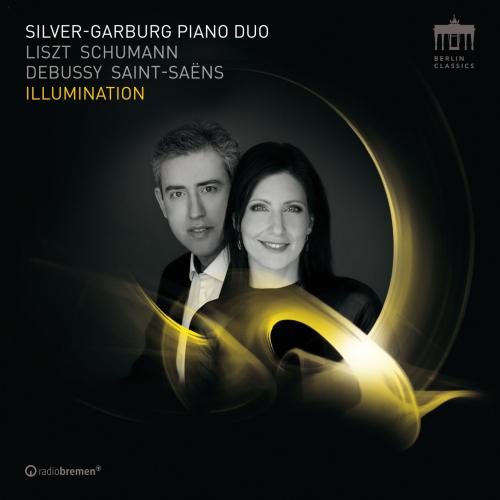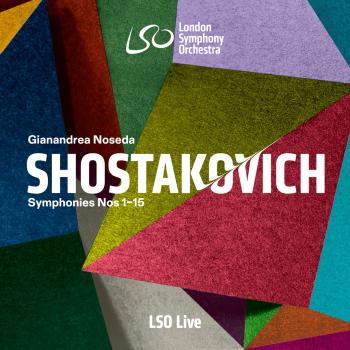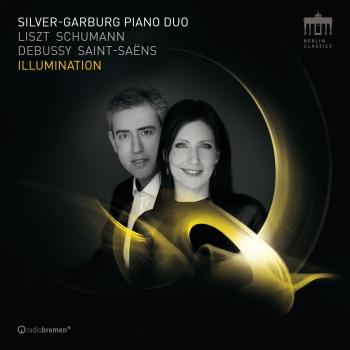
Illumination Silver Garburg Piano Duo
Album info
Album-Release:
2019
HRA-Release:
12.04.2019
Album including Album cover
- Franz Liszt (1811 - 1886): Piano Sonata in B Minor, S.178:
- 1 Piano Sonata in B Minor, S.178: I. Lento assai - Allegro energico (Arr. Camille Saint-Saëns) 12:01
- 2 Piano Sonata in B Minor, S.178: II. Andante sostenuto (Arr. Camille Saint-Saëns) 06:52
- 3 Piano Sonata in B Minor, S.178: III. Allegro energico (Arr. Camille Saint-Saëns) 10:07
- Robert Schumann (1810 - 1856): 6 Studien in kanonischer Form, Op. 56:
- 4 6 Studien in kanonischer Form, Op. 56: I. Nicht zu schnell (Arr. Claude Debussy) 02:19
- 5 6 Studien in kanonischer Form, Op. 56: II. Mit innigem Ausdruck (Arr. Claude Debussy) 03:39
- 6 6 Studien in kanonischer Form, Op. 56: III. Andantino (Arr. Claude Debussy) 01:34
- 7 6 Studien in kanonischer Form, Op. 56: IV. Innig (Arr. Claude Debussy) 03:09
- 8 6 Studien in kanonischer Form, Op. 56: V. Nicht zu schnell (Arr. Claude Debussy) 02:03
- 9 6 Studien in kanonischer Form, Op. 56: VI. Adagio (Arr. Claude Debussy) 03:12
- Camille Saint-Saëns (1835 - 1921):
- 10 Introduction et Rondo capriccioso, Op. 28 (Arr. Claude Debussy) 09:30
Info for Illumination
Performing as a permanent "piano duo" ensemble provides fulfilment and obligation in equal measure: it is a rewarding challenge because the two musicians must always seek the right balance and a suitable combination of skills that they can exhibit at one piano or on two identical instruments. "When we sit at two pianos, we cannot see the other's hands, and when we sit at the same piano, we cannot see each other's face – none of that is necessary. We have a sort of body sensitivity that helps us to communicate with one another on a sub-conscious level and to inspire each other."
It can sometimes be difficult when it is necessary to justify oneself time and again for performing arrangements, simply because the original repertoire for piano duo is limited. The two pianists avoided that problem on "Illumination" because on this album, they have coupled musical masterpieces that were actually arranged for two pianos by famous composers. Three great works, three great arrangers: Liszt arranged by Saint-Saëns, Schumann and Saint-Saëns by Debussy. "All three versions remained utterly true to their reference points and can therefore be seen as 'translations'. The coherence of structure within the imaginative narrative of these Romantic works comes as a revelation in the piano versions," explains Gil Garburg.
However, the fact that these are arrangements is not the driving factor for Silver-Garburg. In fact, they are playing their Liszt, Schumann and Saint-Saëns. They set the focus on the Romantic repertoire: "One of them is a dramatic piece, a huge sonata form uniting all of the movements in a revolutionary manner. Then there is a series of short character pieces which reveal the composer's inner life while they reflect the Baroque era. The last work is a brilliantly entertaining concert piece that aims to enchant and impress in capriccio style." Music played by four hands, brought to life by two Israelis living in Berlin.
"It is easy to make an impression as a piano duo using virtuoso effects. But that alone is not enough," they say. "We have the impression that we have compiled a sort of cyclical programme: Debussy pays tribute to the older French master Saint-Saëns, who in turn honours his esteemed colleague Liszt, who in his turn dedicated his B minor Sonata to Schumann, whose works are now in the safe hands of Debussy."
Sivan Silver, piano
Gil Garburg, piano
No biography found.
This album contains no booklet.












